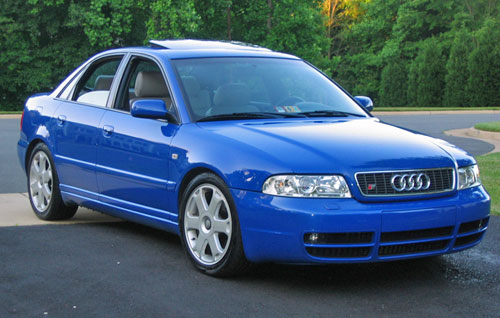The 2000 Audi S4

The 2000 Audi S4. Our intrepid auto reviewer tests this classic ride.
January 30, 2019
For the everyday person, their reaction to my 2000 Audi S4 is, “Huh, I think I’ve seen one of these before.” Even though this isn’t a very common car, especially in 2019, this makes sense. The S4 uses the same body as the very common 1996-2001 Audi A4 sedan and station wagon. The A4 is so common, in fact, that I pass by two every day on my two-minute drive to school.
The similarity to the A4 is part of the S4’s appeal to enthusiasts. At a glance, it is just an executive business sedan, but under the hood, there is a twin-turbo V6 that makes over 100 more horsepower than the garden-variety A4. To those who aren’t into cars, an A4 and an S4 look the same, but there are a few details that enthusiasts pick up on. The 17-inch wheels, different front air dam, and ground effects. This is Audi’s style, changing just enough so enthusiasts will notice, but won’t be conspicuous.
To better understand where the S4 came from, here’s a little background on Audi’s sports cars. In 1983, Audi entered the World Rally Championship with their new sport coupe, the Sport Quattro. Their all-wheel-drive system, Quattro, was completely new and Audi was the only team using all-wheel drive. This shocked competitors and pushed them to develop all-wheel-drive cars of their own. Audi dominated the rally scene until 1987 when the rules changed because cars were getting dangerously fast.
Later that year, Audi took a modified, all-wheel drive 5000S full-size sedan to the Talladega Speedway. On the oval track, Indycar driver Bobby Unser was able to achieve a top speed of 208 miles per hour. In 1988, Audi moved on to the American Trans-Am road racing series to improve their reputation in the States. Again, they were using all-wheel drive against the completely rear wheel drive competition. This time though, the Audis’ turbocharged five-cylinder engines were at a power disadvantage compared to the American manufacturers’ big V8s. Even with the power difference, Audi won 8 of the 13 season races, the manufacturer’s championship, and one of Audi’s team drivers, Hurley Haywood, won the drivers’ championship.
This is far from the end of Audi’s all-wheel reign in motorsports, but we need to get back to the S4. It was the third car that Audi’s Quattro GmbH had released, and the first without their signature five-cylinder turbo engine. Such an engine would not return for over 20 years. Instead, the S4 uses a very complicated 2.7 liter, twin-turbocharged V6 with five valves per cylinder. The result of this German over-engineering is jet-engine-like thrust from anywhere in the rev range. The turbo lag from older Audis is completely gone, just flatten your right foot and you will soon be at autobahn-worthy speeds in complete comfort.
The gearing of the six-speed manual transmission reflects this with wider gears. On higher speed corners, going about 60, the car feels stable and confident. While cruising at any speed, the S4 is composed and comfortable. That composure stays strong under pressure, though. On the tight, winding roads of Tilden Park, the S4’s suspension displays no body roll under hard cornering. Coming into a corner, there are quite enough brakes to get you down to the speed limit, and on the way out the engine and Quattro all-wheel-drive work together to provide a strong corner exit without any wheelspin.
The S4 reflects the evolution of Audi’s sports sedans perfectly. It’s a great piece of engineering, systems working together to create a great all-around driving experience. There’s a lot of tuning potential for enthusiasts, too. As long as you are willing to maintain this car, it will treat you with an outstanding driving experience, no matter where you’re going.

